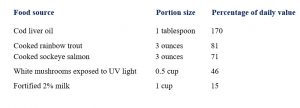How common is vitamin D deficiency
The body uses vitamin D, a fat-soluble vitamin, to increase calcium, magnesium, and phosphate absorption, which is necessary for healthy bone formation and maintenance. To maintain a healthy level of vitamin D in the blood, a concentration of 25-hydroxyvitamin D more than 30 ng/mL is necessary. Numerous issues, most notably rickets in children and osteoporosis in adults, can result from a vitamin D shortage. Rickets was successfully eradicated from the world in the 1930s because to the fortification of milk with vitamin D. However, vitamin D deficiency is more common than ever and has to be evaluated in people at high risk. The link between vitamin D deficiency and cancer, cardiovascular disease, diabetes, autoimmune illnesses, and depression has been the subject of numerous contradicting studies.
Because it is produced by your body from cholesterol when your skin is exposed to sunlight, vitamin D is commonly referred to as the “sunshine vitamin”.
Due to COVID-19, this vitamin has recently drawn a lot of interest for its role in immunological health. Additionally, many vital bodily processes and the health of your bones depend on it.
How frequent is a vitamin D deficiency?
The lack of vitamin D is a widespread problem worldwide. Around 1 billion people globally lack enough vitamin D, and 50% of people are vitamin D insufficient.
Nearly 76 per cent of Indians suffer from Vitamin D deficiency and insufficiency, according to a study published in May 2020 that included 4,624 subjects at 229 sites across 81 cities in India. The prevalence was most common among adults aged 18-30 years.

The health benefits of vitamin D can be found. Among its functions in the body are these:
- Assisting with calcium absorption
- Preserving strong bones
- Controlling genes and cell development
- Avoiding osteoporosis and rickets
- Boosting immune function
What makes vitamin D so crucial?
Your body requires a variety of vitamins to remain healthy, including vitamin D. It is essential for preserving the calcium balance in your blood and bones as well as for bone growth and maintenance.
More precisely, you require vitamin D so that your body can utilise calcium and phosphorus to sustain healthy tissues and create bones.
Hypocalcemia results from a reduction in the absorption of calcium and phosphorus by your intestines due to chronic and/or severe vitamin D insufficiency (low calcium levels in your blood). Secondary hyperparathyroidism is the result of this (overactive parathyroid glands attempting to keep blood calcium levels normal).
If they are both severe enough, hypocalcemia and hyperparathyroidism can both produce symptoms including weariness, sadness, and muscle cramps.
Your body removes calcium from your bones to try to balance the amount of calcium in your blood (through secondary hyperparathyroidism), which speeds up bone demineralization (when a bone breaks down faster than it can reform).
Additionally, this may lead to rickets in youngsters and osteomalacia (soft bones) in adults.
You are more likely to sustain a bone fracture if you have osteomalacia or osteoporosis. Similar to osteomalacia, rickets only affects youngsters. Demineralization results in bowed or bent bones since a child’s bones are still growing.
VITAMIN D Deficiency Prevention
The daily vitamin D needed for maintaining a healthy level of 25-hydroxyvitamin D (25[OH]D) is influenced by a number of factors, including skin tone, exposure to sunlight, nutrition, and underlying medical problems.
The following recommendations for treating vitamin D deficiency are provided by the National Institute for Health and Care Management to doctors:
If a person’s vitamin D level is < 25 nanomoles per litre (nmol/l), recommend treatment.
If the level is 25–50 nmol/l and there are additional signs of the deficiency, therapy is advised.
Advice on how to avoid the shortfall should be given if the level is adequate (over 50 nmol/l).
For eight weeks, or 50,000 IU every week, adults with vitamin D deficiency need to consume 6,000 IU of vitamin D-3 daily.
A doctor may advise taking 2,000 IU of vitamin D daily as a maintenance dose once a blood test reveals that the patient’s level of vitamin D has sufficiently increased. They might also recommend a calcium supplement and provide other dietary advice.
Food sources

Supplements
Vitamins D-2 or D-3 are found in supplements and fortified foods.
D-2 is produced by manufacturers using fungi and yeasts, and this version is acceptable for vegans. To make D-3, they use lanolin from sheep wool.
According to research, vitamin D-2 is less effective than D-3 at larger doses.
Get yourself check with INIGIMA online diagnosis a healthy step for longer life always connected with doctors BOOK NOW
A review article by
Dr Bhavna Kalvala (Clinical Research Director @ IEEARC Tech)
Comments are closed